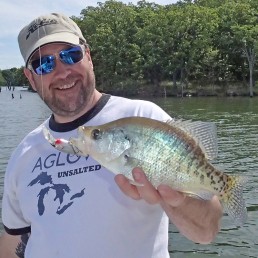Crankbaits for Summer Crappies
SHARE THIS POST
Summer isn’t the most comfortable time to be on the water. As temperatures soar, crappies are often slow to respond to a minnow or jig. However, some lakes have a great response bite when pulling cranks. There’s something about a fast-moving bait that gets a crappie’s attention.
Crankbaits have advantages. They target suspended, scattered crappies that are difficult or impossible to catch with slow techniques. Bites are reactions, so the fish don’t have to be feeding. The technique is good in the wind because the long lines stretch and absorb bounces in waves. Fast trolling is a great way to scout a lake and mark potential spots for fishing later with slow techniques. And it’s fun.
The basics
This system targets suspended fish in open water. At 2.0 miles per hour, a fisherman covers 12 miles in six hours of fishing. Determining the right speed, depth and area leads to great results.
Pulling is the traditional method of trolling baits behind the boat. Northern states may have pole limits that restrict fishermen to one or two poles, but where legal, three poles or more are often used by experienced pullers.
Strong pressure is applied to equipment when a bait hangs on a stump or when a big catfish gets on the line. Therefore, strong pole holders are required. Line is typically 10-pound test monofilament because its diameter is small enough to allow baits to get deep and it stretches to absorb a hard, sudden pull. However, some fishermen use braid to get more depth. Any strong reel can be used, but line counter reels allow depths to be quickly and properly reset.
A six-pole system, often used for two or three fishermen, may include 16-, 12- and 8-foot poles off the sides or back of the boat. The different lengths allow more line spacing between baits for fewer hang-ups and to cover a wider trolling path. Another option is to use planer boards to get baits further away from the boat.
A crankbait must have proper action and stay stable at speeds up to 2.5 mph. Bandit’s 200 and 300 series, Berkley’s Flicker Shad and the Pico INT are good options. It’s very important to keep baits the same on all poles so depths will be consistent.
A boat can be a pontoon, a small aluminum boat or any size in between. It must be safe for the waters and weather. A GPS-controlled trolling motor is best for setting a trolling path and allowing fishermen to attend to poles instead of constantly working the trolling motor. Adjustments can be made remotely from anywhere in the boat.
Are you enjoying this post?
You can be among the first to get the latest info on where to go, what to use and how to use it!
Electronics can be a simple sonar. However, an ideal unit has sonar, side imaging and mapping. Sonar gives depth and shows fish; side imaging shows schools of shad; and mapping aids in navigation and for tracking and repeating trolling runs. Whether you have sonar or multiple units, use each unit’s features to gain the best advantage.
Tips and tactics
Russ Bailey, TV host and former tournament fisherman, has experienced fishing in all conditions on different types of waters. He says, “A lot of things are amazing about pulling crankbaits. One, the hotter it gets, the better the fishing. Two, it’s a fast-moving technique to cover a lot of water in a short amount of time. Three, it’s strictly a reaction bite instead of a hunger bite.
“Areas that produce include points, old roadbeds, flats and channels,” says Bailey. “Fish will suspend up in the water column and nail a crankbait when it comes to them. They hear it coming, see it, and instinct causes them to attack.”
Bailey uses line counter reels. His general rule of thumb is to divide the line distance by 10, then add one, and you have the depth of the bait.
“I like pulling at 1.5 to 2.1 mph. Turns cause a change in bait speed that sometimes triggers bites, indicating that pull speed should be increased or decreased. During a turn, inside baits slow down while outside baits speed up.
“Crappies are very picky about crankbait color, even though they only have a short period of time to see it. Therefore, it’s important to change colors until the right one is found.”
Looking for more ways to increase your catch rate? You’ll find plenty of suggestion in every issue of MidWest Outdoors. Subscribe on our website.
MWO
SHARE THIS POST
You may also like...
Nothing found.
Did you enjoy this post?
You can be among the first to get the latest info on where to go, what to use and how to use it!
Tim Huffman
Tim Huffman specializes in crappie fishing, is editor for two crappie magazines, as well as writing for several others. In 2018, he published his sixth book, Limiting Out for Crappie, available at Amazon. His first article appeared in MidWest Outdoors in 1988.
